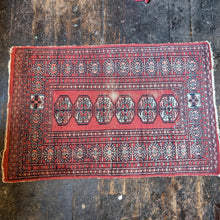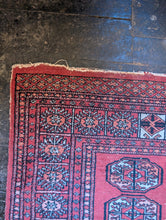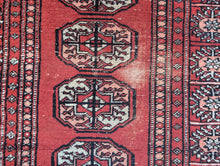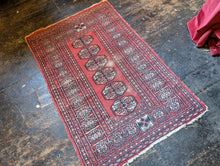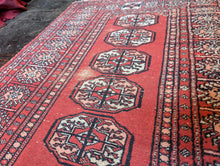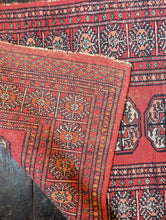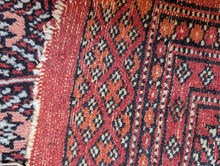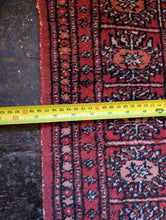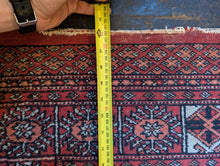
A traditional Bokhara-style rug, hand-knotted in rich red wool with repeating Tekke gul medallions arranged in rows. The field is framed by intricate geometric borders featuring stylised floral motifs and diamond lattice work. This piece has an authentic worn patina consistent with age, including visible fading and pile wear at the centre, giving it a lived-in character that suits rustic or eclectic interiors.
Likely mid 20th century, made using natural wool on a cotton foundation. The rug is finely knotted with a dense weave and displays traditional Turkmen influences.
Condition:
Good vintage condition with surface wear and colour fading, particularly to the central area. Some fraying to the fringes, as shown. Structurally sound and lays flat.
//
Traditional Pakistan Bokhara Carpet (also spelled Bukhara) are among the most popular hand knotted rugs in the world. Many believe that the design originated within or near the (Uzbek) city of Bokhara, but it is actually from the nomadic Tekke tribe in Central Asia (the Tekke tribe's rugs were predominantly traded in the markets of Bokhara, however, and eventually acquired the name of the city).
Likely mid 20th century, made using natural wool on a cotton foundation. The rug is finely knotted with a dense weave and displays traditional Turkmen influences.
Condition:
Good vintage condition with surface wear and colour fading, particularly to the central area. Some fraying to the fringes, as shown. Structurally sound and lays flat.
//
Traditional Pakistan Bokhara Carpet (also spelled Bukhara) are among the most popular hand knotted rugs in the world. Many believe that the design originated within or near the (Uzbek) city of Bokhara, but it is actually from the nomadic Tekke tribe in Central Asia (the Tekke tribe's rugs were predominantly traded in the markets of Bokhara, however, and eventually acquired the name of the city).








